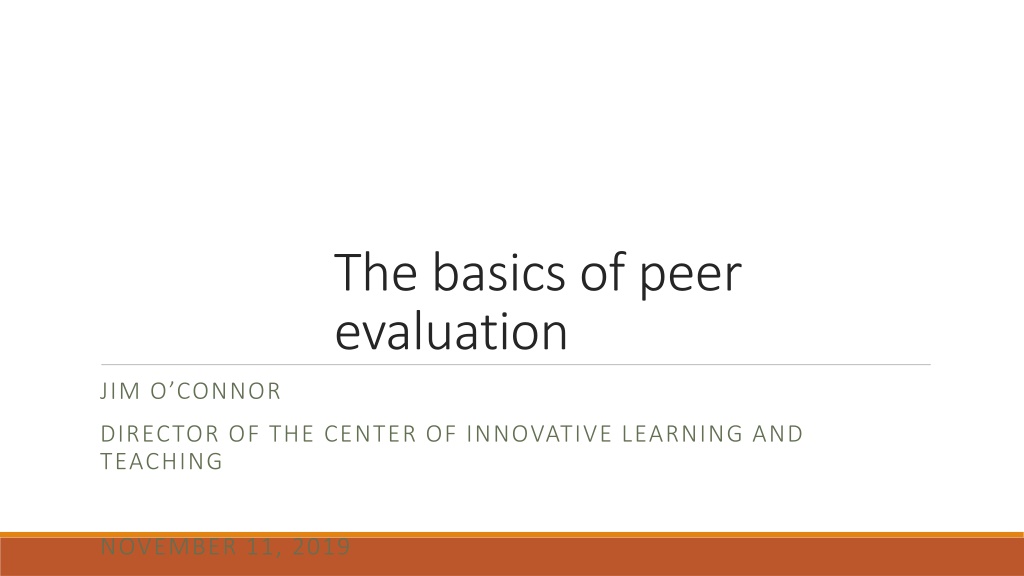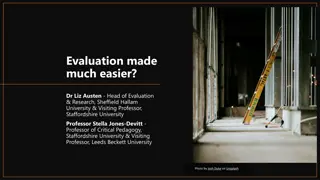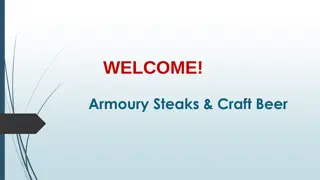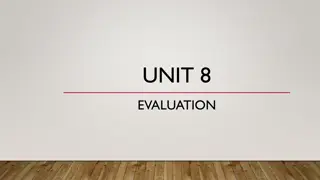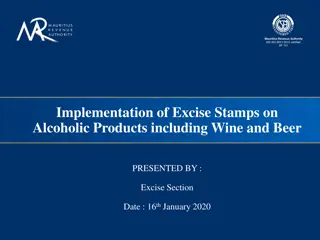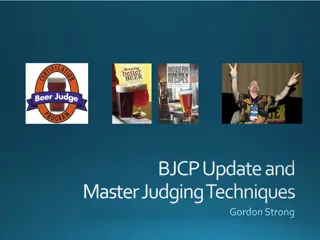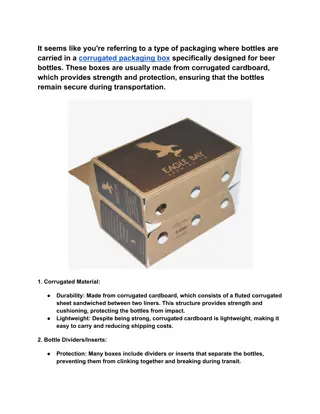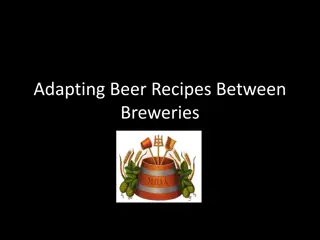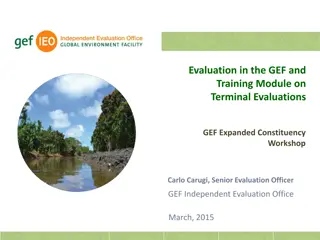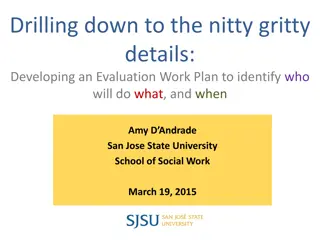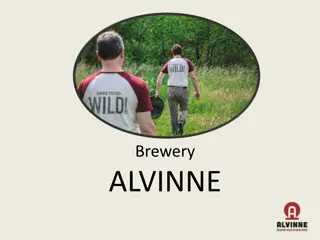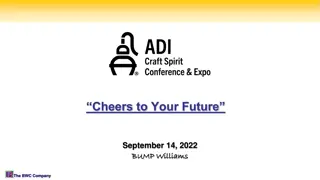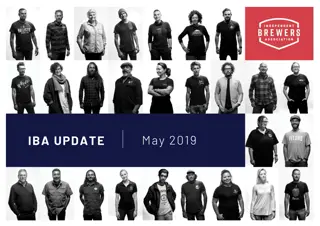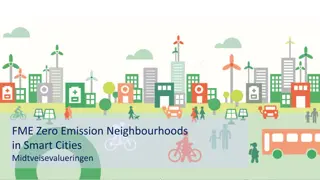The basics of beer evaluation
Peer observation allows university instructors to provide feedback on teaching practices. Assessment and evaluation in teaching are explained, emphasizing the importance of multiple perspectives. The process of peer observation offers flexibility in assessing teaching effectiveness by focusing on various aspects of instruction.
Download Presentation

Please find below an Image/Link to download the presentation.
The content on the website is provided AS IS for your information and personal use only. It may not be sold, licensed, or shared on other websites without obtaining consent from the author.If you encounter any issues during the download, it is possible that the publisher has removed the file from their server.
You are allowed to download the files provided on this website for personal or commercial use, subject to the condition that they are used lawfully. All files are the property of their respective owners.
The content on the website is provided AS IS for your information and personal use only. It may not be sold, licensed, or shared on other websites without obtaining consent from the author.
E N D
Presentation Transcript
The basics of peer evaluation JIM O CONNOR DIRECTOR OF THE CENTER OF INNOVATIVE LEARNING AND TEACHING NOVEMBER 11, 2019
What is peer observation? Peer observation is the process by which university instructors provide feedback to colleagues on their teaching efforts and practices. The process might include, but is not limited to review of course planning and design (syllabus, web presence) review of instructional materials (handouts, exercises, readings, lectures, activities) review of learning assessments (tests, graded assignments) review of in-class interaction with students, and of instructor presentations.
Because teaching is a multi-dimensional job, assessing what we do as teachers requires a multi- faceted approach. No single instrument can capture all aspects of any individual style or method of teaching. Student surveys, for instance, can measure whether student perceptions of what we are doing are aligned with what we ourselves think we are doing; but assessing our teaching requires more than consumer impressions.
What is the difference between assessment and evaluation ? Assessment is the process of objectively understanding the state or condition of a thing, by observation and measurement. Assessment of teaching means taking a measure of its effectiveness. Formative assessment is measurement for the purpose of improving it. Evaluation is the process of observing and measuring a thing for the purpose of judging it, of determining its value, either by comparison to similar things, or to a standard. Evaluation of teaching means passing judgment on it as part of an administrative process, which is summative.
Peer observation offers much-needed flexibility in the assessment of teaching effectiveness. Depending on what a faculty member wants to learn about her/his teaching, a peer can be identified in the instructor s home department in the same content area, so that the observation can be related specifically to an instructor s handling of a given content.
In other circumstances, it might be desirable to find a peer observer outside the instructor s department, in order to focus on non-content concerns, such as the flavor and tone of student- faculty interaction, or the design of a particular activity.
One downside of peer observation is that it may be difficult for even a well-intended observer to filter out his/her own bias against a given teaching method or personality while conducting an observation.
The first-hand witnessing by a colleague of what is happening in the classroom can uncover circumstances that otherwise might remain hidden from the instructor. A peer observer can see how students in the back of the classroom react to something the instructor is doing in the front. This person can report back to the instructor what that view looks like.
Formative assessment of teaching adheres to a few key principles: 1.It is frequent. The goal is to encourage development and track it. 2.It is confidential. The observee needs to feel free to invite candid, including negative, feedback. 3.It is analytical without being judgmental. The observee needs accurate, supportive input from colleagues. 4. It is non-threatening. The assessment should be invited by the observee, and must carry no negative consequences. 5.It is collaborative. The observee should be a partner in deciding which aspects of teaching will be assessed, and who will do it.
A first step in preparing for peer observation is to get clear on: a) what, exactly, you are trying to make happen to your students (how do you want them to change)? b) what teaching methods have you adopted in order to make it happen? c) which teaching tools (methods, techniques, technologies) have you chosen to support that role?
An effective process of peer observation includes the following components. 1.Sharing of relevant course materials with the observer, at least 3 days before the observation: syllabus; lesson plan; planned future quiz, or exam on relevant material, handouts, slides, etc. 2. A face-to-face pre-observation meeting at least one day before the observation, between observer and observee. A meeting just before the class is less effective than an advance meeting.
3.The observation, with note-taking by observer. These notes should resemble those of an anthropologist or ethnographer. The purpose of the notes is not to simply identify problems but to record accurately what happens in class, whether positive or negative. The observer should also write down analytical questions ( Why did you do that? for example) that occur to him/her at particular moments in class, for discussion with the instructor afterward. 4. Reflection by both parties. Both observer and observee need to schedule time to reflect separately after the observation. The Observer needs to analyze his/her notes and identify the primary themes for discussion. The Observee needs to self-assess, and plan questions for the observer that could be used to help analyze the experience.
5.Second face-to-face meeting. A written assessment alone is inadequate in a formative evaluation. The point of this meeting is to share perspectives on what happened, and to reach greater insight on why things occurred the way they did. The observee should state what he/she observed in the classroom experience from the instructor s perspective; the observer should offer corroborations where appropriate, or additional observations and analysis that help the observee more accurately assess the experience.
6.Written Assessment (optional). Depending on how the observee wishes to use the assessment, a write-up is a possible final step in the process. An instructor might want to document a peer observation as part of a teaching portfolio. However, whether or not to use a formative peer observation in a summative assessment has to be the free decision of the observee.
The single most important factor in successful peer observation of teaching is the careful preparation (via orientation and training) of the faculty evaluators.
1. Choose the observer carefully 2. Set aside time for the peer observation 3. Clarify expectations 4. Familiarize yourself with the course 5. Include students 6. Be objective 7. Resist the urge to compare with your own teaching style 8. Do not intervene 9. Follow the general principles of feedback 10. Maintain confidentiality 11. Make it a learning experience
Peer Observation of online classes will include a review of the online course material and a deeper review of a single classroom assignment, including student participation in discussion boards or other interactive exercises.
Peer Observation for Online and Hybrid Courses Faculty members teaching online or hybrid courses will authorize temporary observation to allow for read-only access to all elements of online materials. Evaluation criteria for online courses will be based on the same principles as conventional classroom observation, yet adapted for the unique environment of online learning. Observers should attend to elements such as richness of multi-media content, simplicity and elegance of course design, and frequency and quality of student-instructor interactions.
Based on TCUS Document: What to focus on Lesson has purpose and is meaningful. Objectives are clearly shared The level of difficulty is appropriate for the course. Clear communication Enthusiastic Well prepared Organized Use of appropriate teaching aids
Students are actively listening or participating in class. Students understand desired outcomes of lesson or unit. Discussions and questions are on topic. The cognitive level of the instructor s questions and the class discussion include higher cognitive levels (application, analysis, synthesis and evaluation). Active learning. Variety of activities. Instructor and students demonstrate mutual respect. There are minimal distractions that interfere with student learning. Sufficient instructional resources are available for all. The classroom environment supports the curriculum and adds to student learning.
When conducting the observation, take note of the following: The learning environment(does it feel safe? are the learners relaxed?)- Whether the faculty member states the goal or focus of the session.- Whether the faculty member appears to know the learners and to direct teaching to their level of training. How learners emotions are handled (e.g.disagreement,boredom,frustration,curiosity) How effectively the faculty member s body language, eye contact, voice, and movement support the learning process and demonstrate enthusiasm for the topic. Does the faculty member look mainly at his or her notes, computer or the learners? Does he or she focus on particular learners or parts of the audience?
Other things to focus on 1. Does the instructor monitor the class (withitness)? 2. Does the instructor speak clearly? 3. Does the instructor ask higher order questions? 4. Does the instructor use wait time after asking a question? 5. Checking for understanding 6. Pacing
Time What s Going On Comments/Suggestions
Resources Peer Observation and Assessment of Teaching; A Resource Book for University Faculty, Administrators, and Students who Edited by William Roberson, Ph.D.The Center for Effective Teaching and Learning&Instructional Support Services University of Texas at El Paso Peer Observation of Teaching Handbook Harvard University: Publication ID: MedEdPORTAL ID#: 9150 Publication Citation: Newman L, Roberts D, Schwartzstein. Peer Observation of Teaching Handbook. MedEdPORTAL; 2012. Av Siddiqui, Z.S.,Jonas-Dwyer,D., Carr, S.E.: Twelve Tips for Peer Observation of Teaching: Medical Teacher, 2007, Vol. 29, pp. 297-300.
